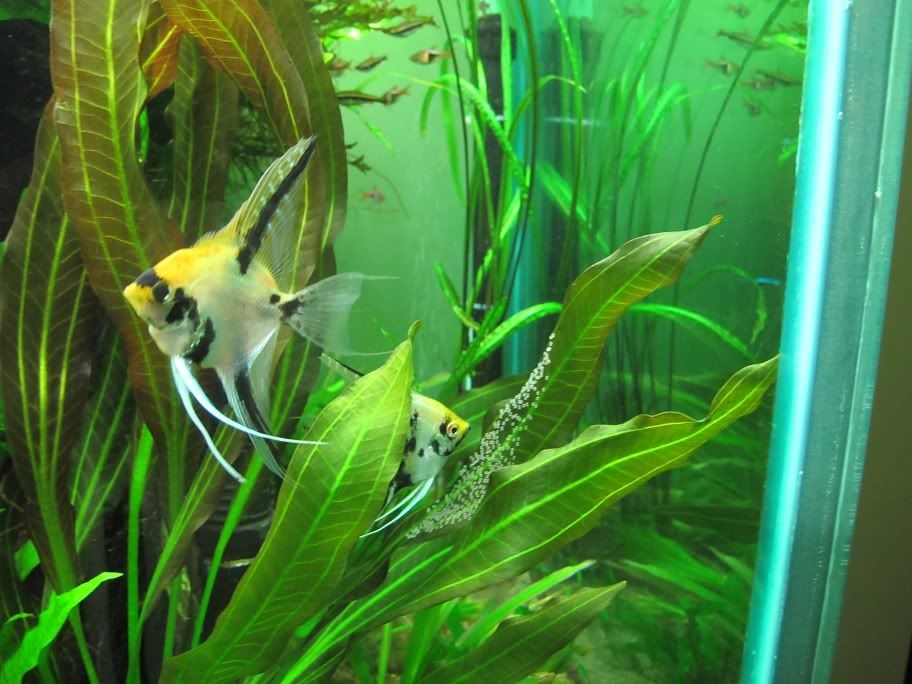Origin, Morphology and Habits of Manvis Fish
I don't know about writing the correct name Manvis or Manfish and also known as 'Angel Fish' comes from the waters of the Amazon, South America. Manvis (Pterophyllum scalare) belonging to the family Cichlidae, has the morphological characteristics and habits as follows:
- Having a variety of colors and types of
- Flattened body shape, with a body like an arrow
- Belly fins and fin width stretches back toward the tail, so it appears as a dark-colored arc transparent
- In the chest there are two long fins that dangle down to the tail.
- Maintain and protect offspring.
- Characteristically omnivorus
- Classified as easily accept a variety of foods in various forms and sources
Some types of Manvis fish known and has been growing in Indonesia include: Diamond (Diamond), Imperial, and Black-White Marble.
Diamond (Diamond) shiny silver-gray to green. At the head of the top there is a yellow to brown-black color that ran up the back. Manfish Imperial has a silver base color, but his body decorated with four vertical black / dark brown. Manfish Marble has a mixture of black and white colors that make up the vertical line. While the Black-White manfish have black adorn the back half of his body, and white colors adorn the front half including the head.
Parent management Manvis fish
Manvis Fish can be used as the parent after reaching age 7 months with a length of ± 7.5 cm. To achieve optimal results, the parent should be well managed among others by such good feeding mosquito larvae, Tubifex worms, or Chironomous. Moreover, because the parent fish manfish very sensitive to the disease, then drug treatment should be given periodically Drugs commonly used include Oxytetracycline and salt.
Before breeding, parent manvis maintained mass (male and female) in advance in a large aquarium (100x60x60 cm 3 size). Once cooked eggs, the parent manfish will pair up and separate from other fish. Parent that these pairs can already be taken and breeding on spawning places.
Moreover, it can be done, namely by the parent pair manfish directly after learning of male and female parent. Male parent is characterized by a larger body size compared to the female parent. The head looks rather large male parent with the section between the mouth to the convex-shaped dorsal fin and body shape slimmer than the female fish. While the female parent is characterized by smaller body size and shape of his head is smaller with a larger belly / fat and looks somewhat prominent.
Breeding technique Manvis fish
Breeding conducted in an aquarium measuring 60x50x40 cm 3 with water height ± 30 cm. Into the aquarium of aeration to supply oxygen.
Manvis Fish will attach their eggs on the smooth substrates, such as pieces of PVC pipe that has been prepared / are placed in the aquarium spawning. Since the fish tend to like the atmosphere manfish a dark and quiet, the aquarium can be affixed to the wall paper or dark plastic.
Manfish parent will spawn at night. Female parent put her eggs on the substrate and followed by male fish which squirts his sperm in all egg, so that the eggs are fertilized. The number of eggs produced per parent ranged between 500-1000 eggs. During the spawning period, the parent still be fed Tubifex worms, Chironomous or Daphnia.
Hatching Eggs and Larvae Maintenance Manvis fish
Eggs are attached to the substrate was then moved to the aquarium penmetasan eggs (measuring 60x50x40 cm 3) for hatching. At hatching medium water should be added an antifungal drug, among others methyline Blue with a dose of 1 ppm. To maintain a stable temperature, then into the egg hatching medium used water heater (water heater) is installed at a temperature 27-28oC.
Manfish eggs will hatch after 2-3 days, with the degree of hatching eggs ranged 70-90%. Furthermore paralon place attachment removed eggs and larvae taken care of up to ± 2 weeks old.
Feed given during maintenance of the larval form of natural food in accordance with the larval mouth opening and has a high protein content, among others, nauplii of Artemia sp. The feed is given 2 times a day (morning and afternoon) to ± 10-day-old larvae and followed by dosing with Tubifex worms.
Nursery and Enlargement Manvis fish
After the age ± 2 weeks, the seed can be thinned to nursery until the fish is then performed at a month old.
The next step is to harvest the seed is to be moved into the tub / container enlargement. In this case can be used like a fiber or cement tanks, depending on the available container. During the period of enlargement, aligned to be no flow of water into the container, although slightly enlarged. For rearing fish density is about 100 ekor/m2 manfish. Given feed or pellets of Tubifex worms up to ± 2-month-old seedlings. The size ranges are achieved usually 3-5 cm. If feed and water quality support, survival rate during enlargement can reach 70-90%. Furthermore, seeds can manfish raised again until it reaches the size of the prospective parent or parent with a smaller density.
Diseases and Abatement Manvis fish
Manfish fish known to be quite sensitive to the disease, it is necessary for the good management by maintaining water quality and quantity of feed given. Several types of parasites that attack the seed / stem Manfish include: Trichodina sp., Chillodonella sp. and Epystilys sp. While the bacteria that infect the Aeromonas hydrophilla.
Several types of drugs that can be used to combat the disease attacks parasitek include: Formalin 25%, NaCl 500 ppm. As for the bacterial disease can be used Oxytetrachycline 50-10 ppm by immersion 24 hours.
reference : http://bbat-sukabumi.tripod.com/
Rating: 4.0


No comments:
Post a Comment
Please contact me if the content is copyrighted from other blog / site, we'll remove relevant content immediately. email: zein1212@yahoo.com